IMPROVE MY GAME
Articles
The Importance of Process-Related Assessment of Golf Skills in Early Stage Junior Development
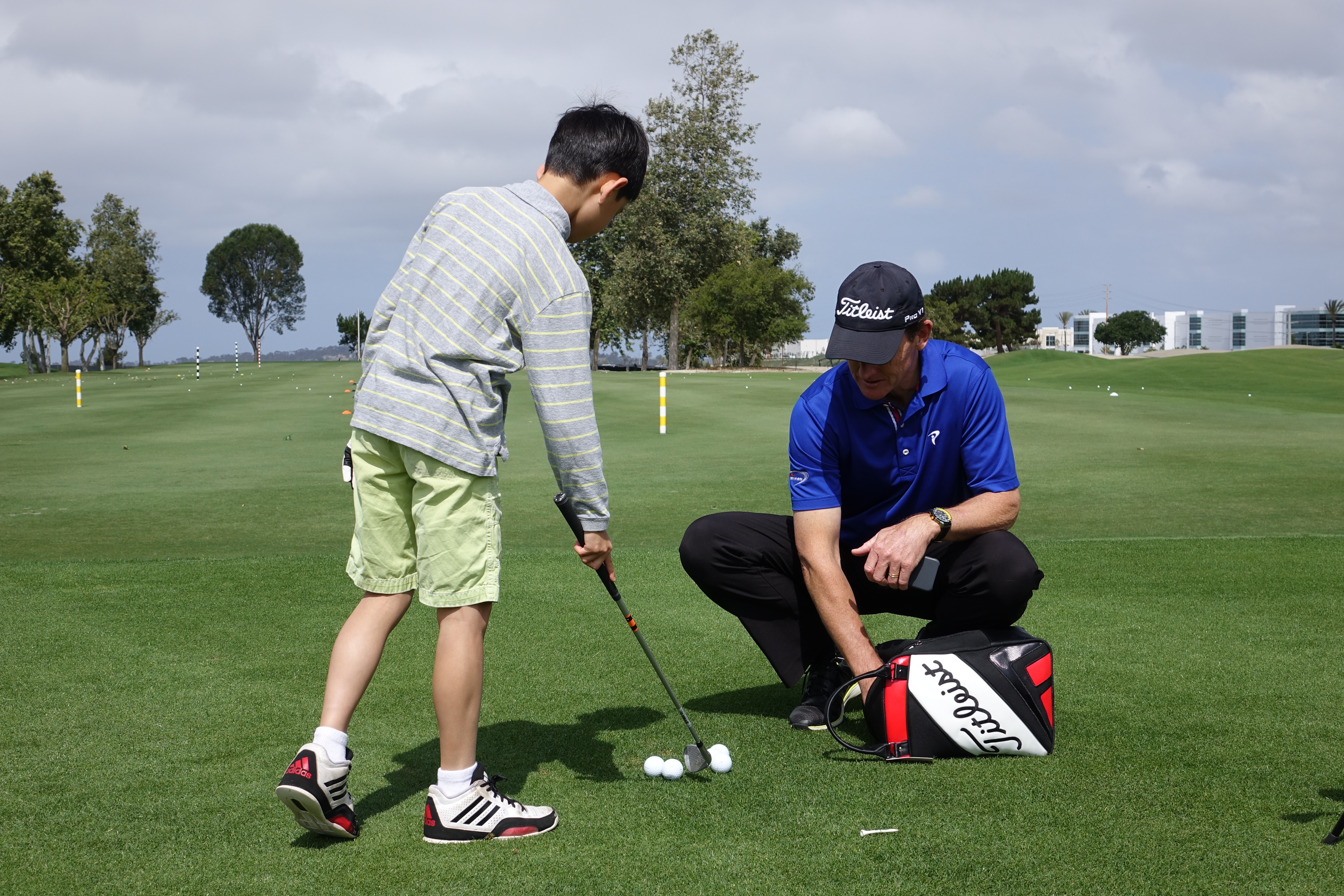
Introduction
The development of physical literacy during childhood and adolescence has been shown to be of critical importance in children’s attitudes and motivation towards future participation in physical activity and sport. Mere exposure to various physical activities, games and sports during these formative years is important to children’s development, but it is not sufficient. The quality of the educational experience leading to the development of physical skills, competencies (knowledge and knowhow) and self-confidence is extremely significant to an individual’s adherence to physical activity leading into adulthood.
This article will explore the notion of physical literacy and the role of community golf programs in the development of healthy and active youth, and secondly, as lifelong golfers (recreationally and/or competitively). More specifically, using Golf Canada’s Future Links program and the Coaching Association of Canada’s Long-Term Athlete Development (LTAD) program as a backdrop, we will examine various assessment practices that can assist golf coaches and instructors in the development of physical literacy (golfing IQ and skill execution) in children and youth participating in our junior programs around the world. As fundamental motor skills, sport-specific skills, golf specific skills and game understanding are crucial to the development of physical literacy during the ages of 6 to 9 years old (FUNdamentals) and 9 to 12 years old (Learning to Train), the use of various assessment practices becomes essential in guiding the teaching and coaching process during these important developmental stages. A critical examination of product and process-oriented assessment practices including their roles and repercussions on early stage junior development will be discussed.
Sport and physical activity for life: Developing physically literate children and youth
Physical literacy is the motivation, confidence, physical competence, knowledge, and understanding to value and take responsibility for engagement in physical activities for life (International Physical Literacy Association, 2014). Developing physically literate children is a responsibility shared by all. First, it is without a doubt that parents have a major influence on a child’s development including their physical literacy. A parent’s engagement towards their child’s activities can have definitive repercussions on the child’s development of fundamental motor skills, and consequently, physical literacy. Secondly, throughout a child’s formative years, school physical education programs have a predominant social responsibility as school curricula are destined to be accessible to the whole population. Finally, many children participate in organized sport. A child’s participation in organized sport such as golf can have a major impact on the development of a child’s physical literacy and influence them towards continuing golf and possibly participating in other types of physical activities and sports throughout adolescence and leading into adulthood.
In order to develop motivation, confidence, physical competence, knowledge and understanding of children and youth, sports programs must create an environment that will nurture these attributes. Why do kids play sports? TPI’s Junior 2 program states (www.mytpi.com):
-
They think it is Fun
-
Their Friends play the sport
-
The feel like they Fit in
-
It makes them Feel Good to play
-
They are Good at the sport
There is no denying that the 3 Fs (fun, friends and fit) are a big part of a program’s attraction. However, the other two factors (feel good and being good) can be directly or indirectly attributed to the quality of the learning experience. The development of physical competency (knowledge and knowhow) has a determining effect on children’s motivation to pursue an activity on a long-term basis (Barnett, Morgan, van Beurden, & Beard, 2008).
During the Fundamentals (6 to 9 years old) and Learning to Train (9 to 12 years old) phases, the development of fundamental movement skills (FMS), fundamental sports skills (FSS) and sport-specific skills (SSS) is gradual and progressive. Content choice and teaching approaches are of major importance in order to ensure ongoing learning and development. Skill assessment approaches also are of major importance in these developmental phases as they can have significant repercussions on the quality of the teaching- learning process.
The Fundamentals and Learning to Train phases: A Critical Period for Skill Development
The continuum of golf skill development is extremely important during the ages of 6 to 12 years old. Beyond the continuation of FMS and FSS development, the Fundamentals phase focuses on the introduction of the golf swing and on putting. During this three-year period, teaching the foundation of these skills is of the upmost importance as the following phase (Learning to Train) is a critical period before the onset of the Peak Hormone Velocity (PHV – puberty) during which skill acquisition and development can and should be a major focus (mytpi – J2). Between the ages of 9 and 12 years old, children’s cognitive development permit them to think in more abstract terms (Bouchard et Fréchette, 2011). This characteristic combined with a good base of FMS and FSS produces excellent conditions for skill development.
Based on this premise, the Fundamentals phase, as the name implies, becomes a crucial period in which a child’s integration of the foundational elements of the golf swing and putting can have an influence on future development. Hence, it goes without saying that the teaching and assessment of these fundamental skills during this period are crucial as they will have a direct influence on future skill acquisition.
Golf Skill Assessment – Practices and Pitfalls
Assessment of FMS at early stages of development typically focuses on object control (reception and or propulsion of an object with either hand or foot), locomotion (travelling from one point to the other) or balance skills (twisting, turning and bending) (Henderson et al. 2005). Process oriented instruments like the Test of Gross Motor Development-2 assess the components or critical elements considered to be important in order to master the skill rather than the skill execution outcome itself (i.e. time, distance, accuracy, etc.) (Burton and Miller, 1998).
Process-oriented instruments are typically used when evaluating FMS as they are more effective in identifying skill deficits. In turn, this allows for better identification of the critical elements of a skill that needs to be focused on in order to improve its execution and essentially, it’s outcome (Morgan, Barnett, Cliff, Okely, Scott, Cohen & Lubans, 2013). Process-oriented assessment of FMS, FSS and SSS in early stages of development can and should be characterised by the use of a series of these critical elements and recorded by an assessor (teacher or coach) as either present (achieved) or not present (not achieved). Process-oriented measures are important for skill assessment of young children as the information can be used to inform the teacher or coach which specific skill components need practice and therefore they can give specific ideas and drills for improvement (Hands, 2002).
Even tough golf might have lost a bit of its participation base over the past few years, it is still a very popular sport in many different areas of the world. Golf’s reintegration into the Olympic Games is certainly a testimony to its global appeal. Hence, many countries around the world have put a lot of effort in attracting children and youth to golf by offering well-grounded parameters guiding junior development. Organisations like The First Tee (USA), Future Links (Canada) and MYGolf (Australia) have developed programs that provide guidance to schools, communities, and parents in ways to increase young children’s golf exposure and education. However, in order to evaluate early stage golfing proficiency, basic or fundamental process-oriented assessments are needed to identify skill deficits and diagnose errors (Winnick, 2009). Assessment results that provide feedback aligned with specific errors that the young golfer needs to improve upon can be of great benefit to teachers, coaches and parents. However, as coaching of young golfers may be offered by individuals with different backgrounds, process-oriented assessments need to be simple enough to accommodate people with varying golf expertise.
There exists a multitude of instruments which assess a range of FMS, FSS and SSS in various sports. However, up until recently, there had been no published reliable and valid process-oriented golf skill assessment instruments. As reported by Robertson, Burnett & Cochrane (2014), a systematic review of tests examining skill outcomes in sport highlighted only three golf tests with documented reliability and/or validity measures. However, none of them were developed for early stage junior golfers.
National programs like the First Tee (USA) and Future Links (Canada) have developed sample product-oriented assessments for children. The Future Links program in Canada uses different product-oriented criteria using benchmarks for moving from one level of the program to the next (See Table 1).
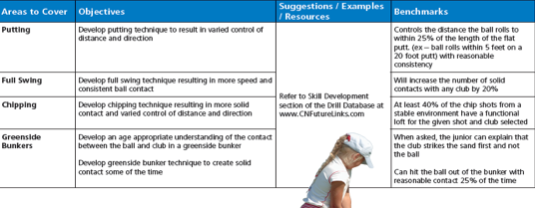
Table 1: Example of benchmarks utilised for promotion of players from one level to a superior level of development (Future Links Program - Golf Canada)
Benchmarks of the sort are very useful in order to assess outcomes and take decisions (summative assessment) on the athlete’s developmental path. However, in order for a child to get to these benchmarks, process-oriented assessments are more useful during the teaching-learning process. Whilst immediate knowledge of results can be motivating to players (Deci and Ryan, 2008) and must still be used, these product tests provide limited diagnostic and formative information for teachers, coaches and parents interested in helping young golfers improve. Process-oriented evaluations targeted towards physical education programs typically evolve from the development of a list of critical elements (Graham, Holt-Hale, & Parker, 2013; Richard, 2010; Rink, 2009).
Golf Swing and Putt Skill Assessment for Children (Barnett, Hardy, Brian & Robertson, 2015)
In order to fill the void of the lack of process-oriented assessments aimed at early stage junior development the research team of Barnett, Hardy, Brian & Robertson in collaboration with several PGA of Australia members developed two separate instruments (rubrics) to assess a) the full swing; and b) the putting stroke. Initial development shows a strong level of validity and intra-observer reliability, meaning it assesses what it intends to and does it with a good level of consistency and stability. The following tables presents the two instruments in question.
Table 2: Golf Skill Assessment: Striking a golf ball (Barnett et al. 2015)
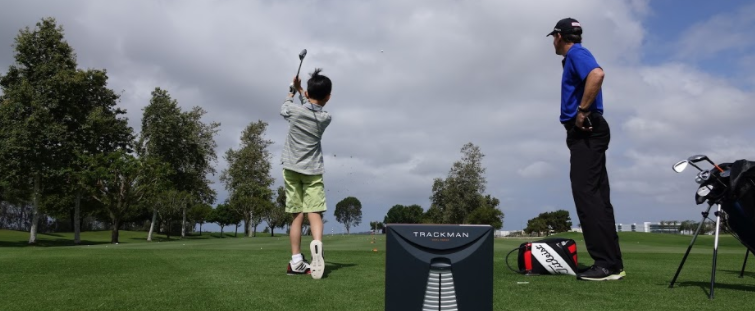
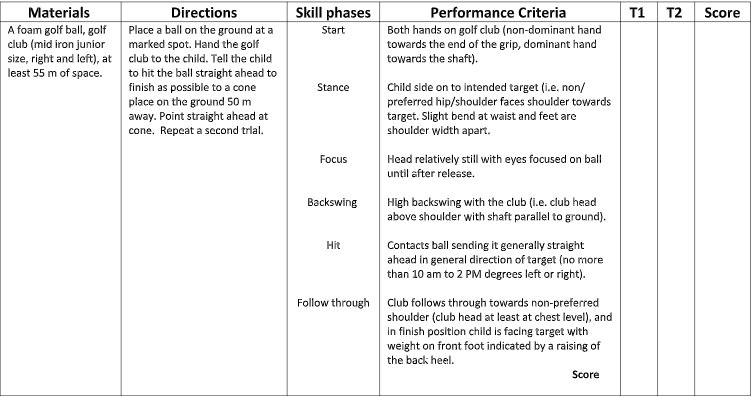
Table 3: Golf Skill Assessment: Putting (Barnett et al. 2015)
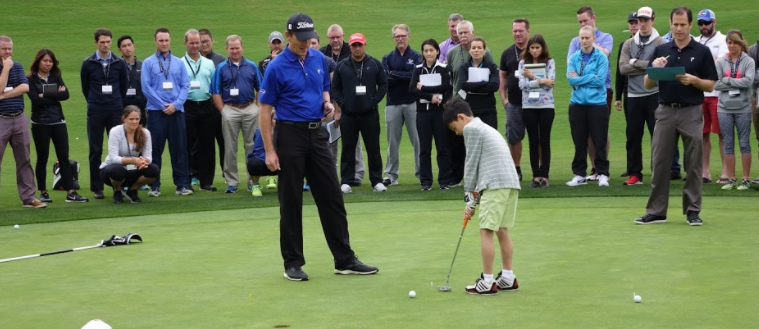
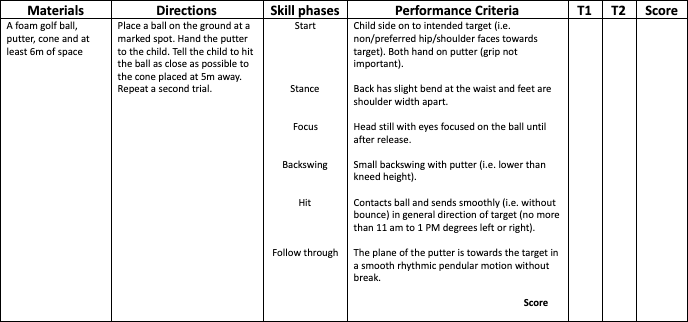
Upon examining the different criteria for each of the instruments, several aspects are apparent:
-
The criteria for each of the skill phases are basic in nature.
Remember, we are assessing the fundamental components of these skills at a 6-9-year-old level (Fundamentals phase). Acquiring and stabilizing technique at this level will serve as a good base for more advanced skill development during the Learning to Train phase (9-12 years old).
-
The criteria for each skill phase are subjective in nature.
It is difficult to assess the process of skill execution in a purely quantitative manner. When assessing or appreciating skill execution, criteria are developed in a descriptive way that leads to a qualitative appreciation of the skill being examined. This being said, the challenge in developing this type of assessment instrument is developing criteria that is written in language that is easily understood and is as objective as possible…even if it is subjective in nature. To this effect, the instruments developed by Barnett et al. (2015) were written in a precise and succinct language that would be easily understood by assessors with varying degrees of golf expertise (i.e. PGA pros, parents, older juniors assisting in instruction, etc.).
Another aspect to the subjectivity issue is the choice of criteria. Concerning these particular assessment instruments, I am certain some PGA pros reading this article have opinions on some of the criteria…I know I have mine. For example, in the Striking a golf ball assessment instrument, some might argue that having the shaft parallel to the ground in the backswing might not have to be a mandatory requirement of technique development at this age level… or any age level for that matter. However, the developers of these instruments that included PGA professionals, took decisions based on what they perceived to be important criteria to guide skill acquisition at this stage of development. From the decisions that were taken, the two instruments presented measured different skill levels (mediocre skill execution versus higher skill execution) very well.
-
The criteria for each skill phase will help in identifying skill deficiencies and guide teaching
As mentioned earlier, the critical or fundamental elements in each of the skill tests developed by Barnett et al. (2015) are pretty general as they represent the foundation to be adopted at an early stage of development. They provide reference points as to the different elements of posture, position and motor behaviors to adopt that will serve as a platform for skill development and performance leading into later stages of development (i.e. Learning to Train phase and beyond). Instruments of this type help to guide teachers and coaches, with varying degrees of expertise, to be able to identify critical elements that are problematic and affect the performance outcome. Being able to diagnose critical elements that are problematic greatly helps teachers and coaches in planning their interventions as they have a better idea of what to address with each particular child.
Moving Forward
The literature on the motor skill acquisition in early-stage development is pretty clear: focusing on the process of performance is an important component in improving the teaching-learning process in order to improve skill development (Morgan et al. 2013; Rink, 2009). Frankly, it is just an integral part of good teaching/coaching, especially in early-stage development in which the basis of skill acquisition and proper technique serve as the foundation for later development.
The instruments put forward by Barnett et al. (2015) are well developed and should serve a basis for future research and development of other instruments that could be useful in the assessment process of skill acquisition during early stage junior development. Here are a few paths the need to be explored:
-
Continue validation and reliability development of these tools with assessors of varying levels of golf expertise.
Since junior programs are not always offered by PGA professionals, having assessment instruments that are easily accessible and can be understood by instructors with varying levels of expertise is important. Hence, further studies should focus on reliability analyses with parents and older juniors who often assist PGA pros or other instructors in junior programs.
-
Develop different versions of the Striking a golf ball and Putting instruments (Barnett et al. 2015) and add chipping and bunker assessment instruments for the 9-12-year-old age bracket (Learning to Train).
Initial development of the Striking a golf ball and Putting assessment instruments were destined for the 6-9-year-old age group. Hence, certain parts of the testing conditions were adapted for the targeted age group (i.e. using a foam ball instead of a golf ball). I am of the opinion that these instruments would also be useful at the Learning to Train phase where skill development is a major focus. Hence, validity and reliability of the two instruments developed by Barnett et al. (2015) should be examined using a real golf ball. Moreover, chipping-pitching and bunker play assessment instruments focusing the process of skill execution should also be developed for this age group as these skills will also be a major focal point during the Learning to Train phase of development.
It is also of note that a reliability study with children using these instruments in a self or peer assessment setting should also be accomplished. Peer and self-assessment can be very powerful in children’s learning process and it should not be underestimated that children in this developmental age bracket (9-12 years old) do not possess the cognitive capabilities of observing motor skills with a good level of precision (Richard, Godbout and Gréhaigne, 2000). When using assessment instruments that are presented at an age appropriate level combined with appropriate supervision by a teacher or coach, peer or self-assessment (directly or through video) can contribute to a child’s learning and development of sports skills (Richard et al. 2000; Richard, 2010). Learning through observation can help youth develop sound judgment leading to self-correction capabilities and eventually, more autonomy. Isn’t this what we strive for as teachers and coaches?
Conclusion
Part of TPI’s philosophy is to assess and not guess. It is a very sound statement and it applies in different contexts, including everything that is developmental and educational in nature. In the context of junior golf development, utilizing outcomes or benchmarks are an instrumental part of gauging children and youth’s skill acquisition. However, during the critical phases of development from 6 to 12 years old, focusing the process of skill execution is imperative. Consequently, formally assessing the skill acquisition process during this important period will enhance the teaching learning process and improve skill acquisition in our junior golfers leading to enhanced physical literacy, better performance and hopefully, more fun!
Barnett et al.’s (2015) work is a step in the right direction towards enhanced assessment and teaching practices in junior golf. I presented on this topic at the 2020 PGA of Canada Atlantic Zone Education Conference earlier in the year. I would like to thank my fellow PGA of Canada professionals in attendance for their constructive ideas in applying these assessment instruments, modifications to be considered, and other potential golf skill process-oriented assessments to be developed in the future.

Jean-François Richard has spent the past 21 years in higher education as a professor, researcher and administrator at the Université de Moncton, New Brunswick Canada. A graduate from Université Laval (Québec City) in 1998 with a doctorate (Ph.D.) in Physical Activity Sciences, Jean-François has also spent a significant part of his career as a coach and coach educator, mostly in hockey and athletics. Dr. Richard has authored over 40 refereed publications in relation to the teaching-learning process in various physical activity and sport settings including co-authorship of several books. In 2007, Health and Physical Education Canada awarded Jean-François the Dr. R. Tait Mackenzie Scholar Award for his contributions to the body of knowledge in relation to teaching and teacher education. Jean-François is a PGA of Canada Apprentice Professional and is TPI certified G2 and J2. He teaches and coaches at the Louis Melanson Golf Academy at the Fox Creek Golf Course in Dieppe New Brunswick. Email: richarjf@umoncton.ca
References
Barnett, L.M., Hardy, L.L., Ali, B.S. & Robertson, S. (2015). The development of a golf swing and putt skill assessment for children. Journal of Sports Science and Medicine (2015) 14, 147-154.
Barnett, L.M. Morgan, P.J., van Beurden, & Beard, J.R. (2008). Perceived sports competence mediates the relationship between childhood motor skill proficiency and adolescent physical activity and fitness: a longitudinal assessment. International Journal of Behavioral Nutrition and Physical Activity 5 :40. Available online : https://www.ncbi.nlm.nih.gov/pmc/articles/PMC2569960/
Bouchard, C. et Fréchette, N. (2011). Le développement global de l’enfant de 6 à 12 ans en contextes éducatifs (The development of 6 to 12 year old children in educational settings). Québec : Les presses de l’Université du Québec.
Burton A.W., Miller D.E. (1998) Movement Skill Assessment. Champaign, IL: Human Kinetics.
CGPA (2014). Golf Canada in partnership with the Canadian Golf Professional Association (CGPA). Long-term player development guide for golf in Canada [Online]. Available: URL: http://www.golfcanada.ca/about-us/sport-development/long-term-player-development/
Deci E.L., Ryan R.M. (2008) Self-Determination Theory: A Macrotheory of Human Motivation, Development, and Health. Canadian Psychology 49(3), 182-185.
Graham G., Holt-Hale S., & Parker M. (2013) Children Moving: A reflective approach to teaching physical education. New York : McGraw-Hill.
Hands B.P. (2002) How can we best measure fundamental movement skills? In: Proceeding of the Australian Council for Health, Physical Education and Recreation Inc.
Henderson S.E., Sugden D.A., Barnett A.L. (2007). Movement assessment battery for children-2: Movement ABC-2: Examiner’s manual. Pearson.
https://futurelinks.golfcanada.ca
https://www.mytpi.com
https://www.physical-literacy.org.uk
Morgan P.J., Barnett L.M., Cliff D. P., Okely A.D., Scott H.A., Cohen K E., Lubans D.R. (2013) Fundamental movement skill interventions in youth: A systematic review and meta-analysis. Pediatrics 132 (5), e1361-e1383.
Richard, J-F. (2010). Student Involved Formative Assessment as a Cornerstone to the Construction of Game Performance. In Teaching Games for Understanding: Theory, Practice and Research. Champaign, IL: Human Kinetics Publishers.
Richard, J.-F., Godbout, P., & Gréhaigne, J.-F. (2000). Students’ precision and reliability of performance assessment in team sports. Research Quarterly for Exercice and Sport, 71(1), 85-91.
Rink J. (2009) Teaching physical education for learning. NY, McGraw-Hill.
Robertson S.J., Burnett A.F., Cochrane J. (2014). Tests examining skill outcomes in sport: a systematic review of measurement properties and feasibility. Sports Medicine 44(4), 501-518.
Winnick J. (2009). Adapted physical education and sport. Champaign, IL, Human Kinetics.